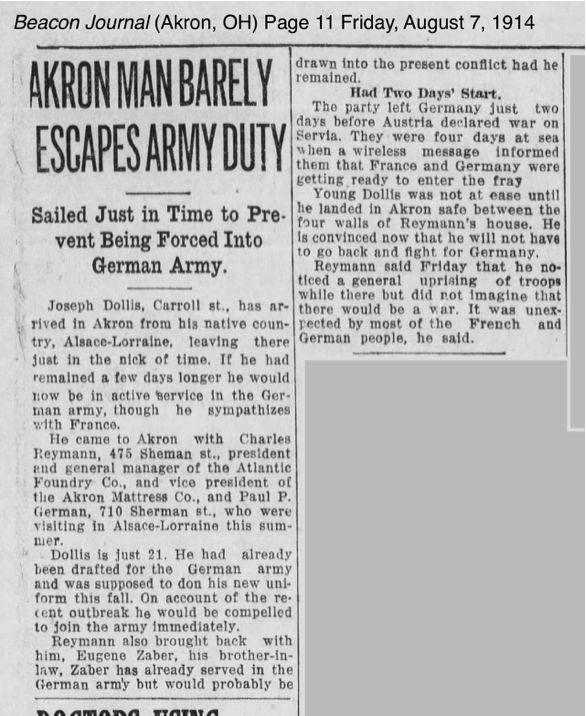
Reymanns love to spin a yarn. One of my favorite childhood memories is looking forward to the stories I would hear at family gatherings from my great-uncles and grandfather about their youth. Stories of home cooked meals, feats of sportsmanship, or good fortune, and military service, along with misadventures and mix-ups, all told with wit and humor. I enjoyed hearing these conversations that grew into near tall tales in my mind as different, seemingly minor details, were added each time giving fuller context to events that had taken place perhaps three quarters of a century earlier.
One story of good fortune I heard several times was of a harrowing escape from Alsace-Loraine by Charles Reymann Sr. at the onset of World War One.
Several different versions were told but all had the same arch, that following a foundry accident that damaged one of his eyes, Charles Reymann travelled to France in hopes that he would receive a miracle that would restore his vision. At the time, Paris was a world center of medical research and teaching. Though if a medical miracle wasn’t possible, a spiritual miracle would perhaps be received by a visit to the Grotto of Massabielle in the Sanctuary of Our Lady of Lourdes, France. However, the trip would be cut short as the turmoil over the assassination of Austrian Archduke Ferdinand was growing from a regional conflict into one that would consume Europe. Speculation in the story was that Charles feared the possibility that he would have to fight for either Germany or France and fled the continent to save his life. The story featured elements that are as exciting now as they were in my youth.
Working as a professional preservationist and architectural historian I research buildings and the people who brought them to be. Many times, details and events I learn from oral histories differ from what is found in period documents or physical evidence. Knowing this, I had long chosen to let the stories I cherished hearing as a child to remain just stories and not look into ways to independently confirm the veracity of the sometimes seemingly outrageous claims that were made. I now realize this story was often being retold by my great-uncles who were only born after the events transpired.
One evening after a family dinner we were discussing the many recent WWI movies we had seen, They Shall Not Grow Old, 1917, and All Quite on The Western Front. It wasn’t long before the story of my great grandfather’s escape from Alsace-Lorraine at the beginning of the conflict was told. Curiosity finally won me over and I looked for ways to confirm this story though I didn’t expect to find the truth so quickly, nor confirming much of the story as true.
I first turned to the digitized archives of the Akron Beacon Journal, beginning my search by building a background profile of my great-grandfather. However, before long I found the very information I was seeking. In the Friday, August 7, 1914 edition of the Beacon Journal the paper ran a headline “Akron Man Barely Escapes Army Duty.” The man was identified as Joseph Dollis, who along with Charles left Alsace-Lorraine just two days before Austria and Serbia declared war. After 4 days at sea, they learned France and Germany had joined the conflict. Charles was quoted in the article as saying that he “noticed a general uprising of troops while there but did not imagine that there would be a war. It was unexpected by most of the French and German people.”
Accompanying the pair on the trans-Atlantic crossing was the father of Charles’ first wife, Paul Germann, who had traveled to Alsace-Lorraine with Charles, and Eugene Zaber, Salome Reymann’s brother. While Zaber had previously completed his mandatory service in the German army, with the outbreak of war he was at risk of compulsory reenlistment and chose to leave his homeland for America.
The December after Charles returned from Alsace-Lorraine he purchased seven lots in the Trolley View subdivision from Clark & Alice Woolf for $4,700, roughly $150,000 in 2025. Around this same time, Salome became pregnant with Vincent, my grandfather. Needless to say, life would have turned out quite differently for many of us had Charles not escaped Europe when he did.
While the story didn’t turn out exactly the way it was told, these new details reflect Charles Reymann’s servants’ heart to help those in dire need of their own miracle.
